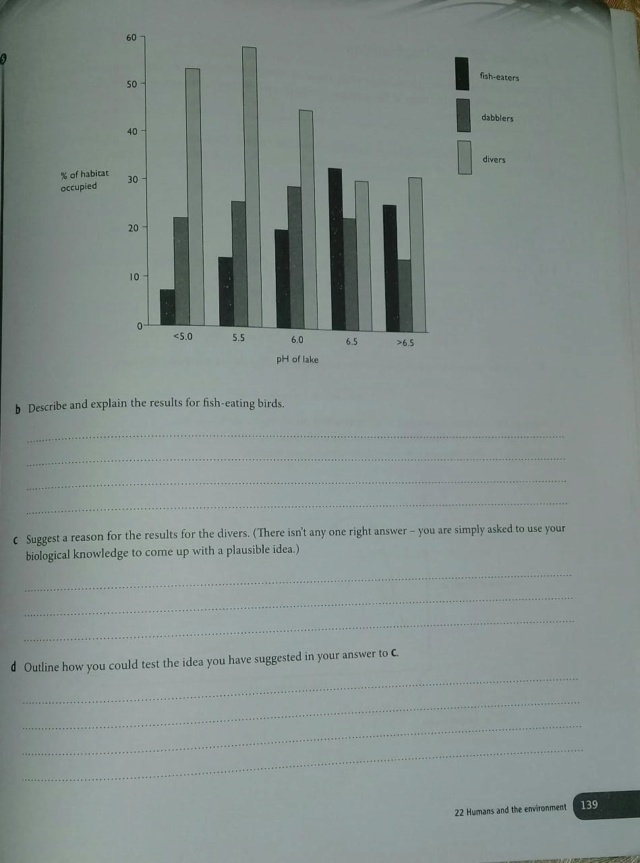Humans and the environment
. :: الصف العاشر GR10 :: الأحياء Biology
صفحة 1 من اصل 1
 Humans and the environment
Humans and the environment
04.26.2020
09:11:05
Science/ grade 10- Today’s topic-Pesticides and chemical waste.
Course book-305 and 306.
Main points-
Insecticides:
eg DDT controls spread of malaria by killing mosquitos which carry the protoctist parasites that cause the disease.
Remains in the environment after it has been sprayed and can be absorbed in sub-lethal doses by microscopic organisms – can enter food chains and accumulate as it moves up them.
Persist for a long time in the soil, rivers, lakes and bodies of animals, including animals.
Chemical waste:
Many industrial processes produce poisonous waste products.
Electroplating produces waste containing copper and cyanide. If these chemicals are released into rivers they poison the animals and plants and could poison humans who drink the water.
Any factory getting rid of its effluent into water systems risks damaging the environment.
Some detergents contain a lot of phosphate. This is not removed by sewage treatment and is discharged into rivers.
The large amount of phosphate encourages growth of microscopic plants (algae).
Discarded rubbish:
The domestic waste from a town of several thousand people can cause disease and pollution in the absence of effective means of disposal.
Much ends up in landfill sites, taking up valuable space, polluting the ground and attracting vermin and insects, which can spread disease.
Air pollution can be caused by burning waste.
Plastics and the environment:
Plastics that are non-biodegradable are not broken down by decomposers when dumped in landfill sites or left as litter.
This means that they remain in the environment, taking up valuable space or causing visual pollution.
Discarded plastic bottles can trap small animals; nylon fishing lines and nets can trap birds and mammals such as seals and dolphins.
As the plastic in water gradually deteriorate, they fragment into tiny pieces, which are eaten by fish and birds, making them ill.
When plastic is burned, it can release toxic gases.
Pollution by contraceptive hormones:
When women use the contraceptive pill, the hormones in it (oestrogen or progesterone) are excreted in urine and become present in sewage.
The process of sewage treatment does not extract the hormones, so they end up in water systems such as rivers, lakes and the sea.
Their presence in this water affects aquatic organisms as they enter food chain.
male frogs and fish can become ‘feminised’ (they can start producing eggs in their testes instead of sperm).
This causes an imbalance between numbers of male and female animals.
Drinking water, extracted from rivers where water from treated sewage has been recycled, can also contain the hormones.
Homework is given- Humans and the environment-workbook- pages 138 and 139.


09:11:05
Science/ grade 10- Today’s topic-Pesticides and chemical waste.
Course book-305 and 306.
Main points-
Insecticides:
eg DDT controls spread of malaria by killing mosquitos which carry the protoctist parasites that cause the disease.
Remains in the environment after it has been sprayed and can be absorbed in sub-lethal doses by microscopic organisms – can enter food chains and accumulate as it moves up them.
Persist for a long time in the soil, rivers, lakes and bodies of animals, including animals.
Chemical waste:
Many industrial processes produce poisonous waste products.
Electroplating produces waste containing copper and cyanide. If these chemicals are released into rivers they poison the animals and plants and could poison humans who drink the water.
Any factory getting rid of its effluent into water systems risks damaging the environment.
Some detergents contain a lot of phosphate. This is not removed by sewage treatment and is discharged into rivers.
The large amount of phosphate encourages growth of microscopic plants (algae).
Discarded rubbish:
The domestic waste from a town of several thousand people can cause disease and pollution in the absence of effective means of disposal.
Much ends up in landfill sites, taking up valuable space, polluting the ground and attracting vermin and insects, which can spread disease.
Air pollution can be caused by burning waste.
Plastics and the environment:
Plastics that are non-biodegradable are not broken down by decomposers when dumped in landfill sites or left as litter.
This means that they remain in the environment, taking up valuable space or causing visual pollution.
Discarded plastic bottles can trap small animals; nylon fishing lines and nets can trap birds and mammals such as seals and dolphins.
As the plastic in water gradually deteriorate, they fragment into tiny pieces, which are eaten by fish and birds, making them ill.
When plastic is burned, it can release toxic gases.
Pollution by contraceptive hormones:
When women use the contraceptive pill, the hormones in it (oestrogen or progesterone) are excreted in urine and become present in sewage.
The process of sewage treatment does not extract the hormones, so they end up in water systems such as rivers, lakes and the sea.
Their presence in this water affects aquatic organisms as they enter food chain.
male frogs and fish can become ‘feminised’ (they can start producing eggs in their testes instead of sperm).
This causes an imbalance between numbers of male and female animals.
Drinking water, extracted from rivers where water from treated sewage has been recycled, can also contain the hormones.
Homework is given- Humans and the environment-workbook- pages 138 and 139.


srimathi- المساهمات : 990
تاريخ التسجيل : 15/09/2018
 مواضيع مماثلة
مواضيع مماثلة» Humans and the environment
» Humans and the environment
» Humans and the environment
» Humans and the environment
» Humans and the environment
» Humans and the environment
» Humans and the environment
» Humans and the environment
» Humans and the environment
. :: الصف العاشر GR10 :: الأحياء Biology
صفحة 1 من اصل 1
صلاحيات هذا المنتدى:
لاتستطيع الرد على المواضيع في هذا المنتدى



